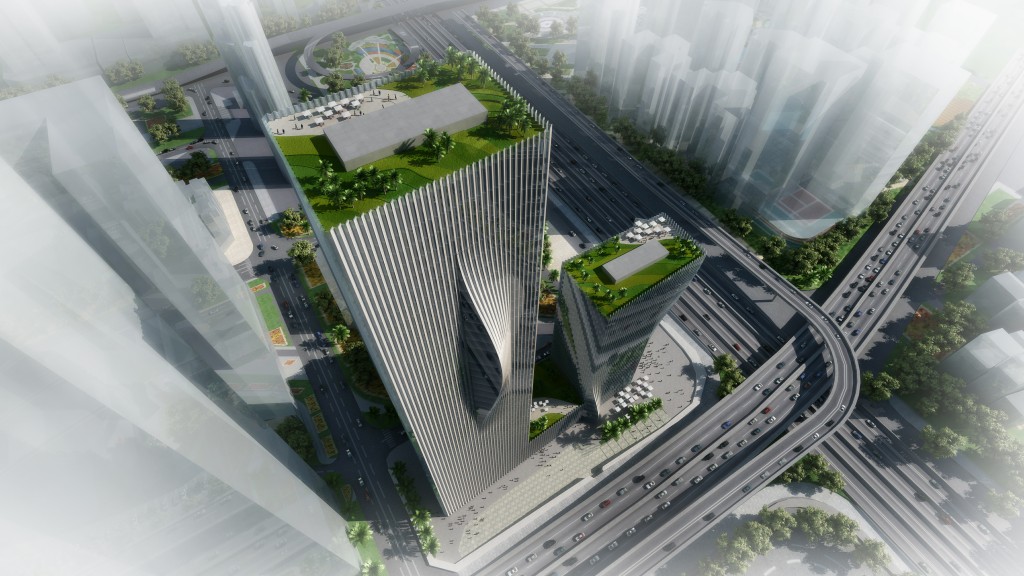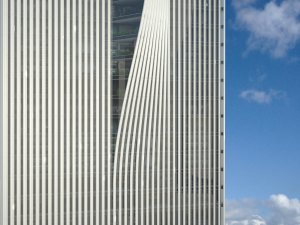Ground breaking will soon occur on one of the most innovative towers yet built in the city of Shenzhen. Invited as one of six architecture firms, Bjarke Ingels Group (BIG), in collaboration with ARUP and Transsolar, was recently awarded first-prize in an international competition to design the Shenzhen International Energy Mansion.
 The purpose of the international design competition was to find a sustainable and efficient solution for the Shenzhen Energy Company office headquarters. Located in the centre of Shenzhen, the 96,000 square meter project will be integrated with the surrounding environment and designed to withstand the tropical climate of the city. BIG’s winning proposal was selected by the jury experts from Shenzhen Municipal Planning Bureau chaired by Alejandro Zaera-Polo and client representatives.
The purpose of the international design competition was to find a sustainable and efficient solution for the Shenzhen Energy Company office headquarters. Located in the centre of Shenzhen, the 96,000 square meter project will be integrated with the surrounding environment and designed to withstand the tropical climate of the city. BIG’s winning proposal was selected by the jury experts from Shenzhen Municipal Planning Bureau chaired by Alejandro Zaera-Polo and client representatives.
The headquarters will rise to a height of 200 meters, creating a new landmark visible from the highway in the cultural, political and business center of Shenzhen. BIG envisions combining a practical and efficient floor plan layout with a sustainable façade that both, passively and actively reduces the energy consumption of the building. The façade is conceived as a folded skin that shades the office complex from direct sunlight and integrates solar thermal panels, reducing the overall energy consumption of the building.
Design Evolution
BIG states that the skyscraper has evolved as an economically efficient way to provide flexible, functional and well illuminated workspaces for dense populations of professionals. It has, however, evolved at a time when air conditioning and electric lighting were merely seen as modern solutions to modern demand, without thought being given to environmental consequences or energy shortages.
Today, the skyscraper needs to evolve into a new sustainable species. It must retain its highly evolved qualities such as flexibility, daylight, views, density and general usability whilst advancing new and untested attributes such as ways of combining maximum daylight exposure with minimal sunshine exposure or integrated ways of limiting the need for cooling.
”We propose to make the Shenzhen Energy Mansion the first specimen of a new species of office buildings that exploits the building’s interface with the external elements – sun, daylight, humidity, wind – as a source to create maximum comfort and quality inside. The Shenzhen Energy Mansion will appear as a subtle mutation of the classic skyscraper – a natural evolution rather than a desperate revolution,” stated Bjarke Ingels, Founding Partner, BIG.
Curtain wall
 BIG believes that the traditional glass façade has little insulation leaving offices overheated by direct sunlight. This results in excessive energy consumption for air conditioning and the need for a heavy glass coating that makes the view seem permanently dull and grey.
BIG believes that the traditional glass façade has little insulation leaving offices overheated by direct sunlight. This results in excessive energy consumption for air conditioning and the need for a heavy glass coating that makes the view seem permanently dull and grey.
”The towers are based on an efficient and well-proven floor plan enclosed in a skin specifically modified and optimized for the local climate. By focusing on the envelope, the façade, we are able to enhance the sustainable performance of the building drastically,” said Andreas Klok Pedersen, Project Leader, BIG.
By folding the façade in an origami like shape BIG has achieved a structure with closed and open parts. The closed parts will provide a highly-insulated façade, whilst blocking the direct sunlight. On the outside the closed parts are to be fitted with solar thermal heat panels that will power the air conditioning and provide dehumidification for the working spaces.
The folded wall will provide a free view through clear glass in one direction creating a condition with plenty of diffused daylight by reflecting the direct sunlight between the interior panels. Even with direct sun from east or west, the majority of the solar rays will reflect off the glass, due to the flat angle of the window. The reflected rays will increase the efficiency of solar thermal energy panels. The combination of minimal passive solar heating and active solar panels are expected tp reduce the stylish, modern building’s energy consumption by more than 60%.












